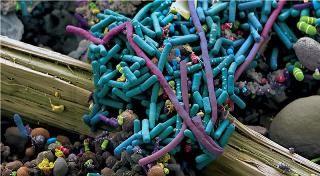A group of scientists from the Institute of Ecology and the Faculty of Medicine of the National University of Mexico (UNAM), created a membrane capable of simultaneously detecting numerous organisms in the water or food that cause diarrhea and intestinal problems. This health problem annually kills 760 000 children under the age of five, according to the World Health Organization.

PhD Valeria Souza Saldivar, responsible of the technological development, said that this is an analysis system consisting of a transparent, flexible material, similar to paper that measures 10x5 centimeters, in which 200 points with the genes of pathogenic microorganisms were printed.
The innovation called "Macroarrangement for detection of enteric microorganisms in environmental and biological samples ", is designed to detect microorganisms in water, the main vehicle for transmitting bacteria that cause diarrhea, especially when the untreated liquid is used to water or wash food. "It's what happens in the Lerma Santiago River, which crosses the State of Mexico, Jalisco, Guanajuato and Michoacan (center and east states of Mexico); there are no treatment plants and human and industrial waste accumulate in this body of water" said the specialist in molecular evolution.
For 10 years, the researchers studied the genes in the bacteria responsible for the diarrhea, "we obtained all the genes that these bacteria have, removed them through a process called 'PCR', ie a method that allows us to amplify DNA fragments to identify disease-causing germs; with this, the Faculty of Medicine can print 200 points on the membrane with the genes of microorganisms in a particular order, " explained the academic.
The scientific development has a baseline cost of 500 thousand pesos, and a high profit, as it has many simultaneously active genes, which helps to obtain an accurate diagnosis.
Souza Saldivar explained that currently the membrane is in the process of patenting and allied with the company Encore Biotechnology, is intended to carry out a co-development project to detect pathogens in cultured shrimp of Nayarit, Sinaloa and Sonora. "We found that our membrane not only distinguished the Vibriosis, ie crustaceans cholera; but also that this disease came from many toxins in the contaminated water causing the early death of the animals."
With the test results, the scientists seek to generate sustainable development through the use of the same bacteria and the creation of probiotics to replace chemicals or antibiotics. "We need to work with bacteria, not against them," the researcher emphasized.
Is important to highlight that this innovation placed third in the awards program for the Promotion of Patenting and Innovation in Mexico that promotes technological development and a culture of industrial property in the National University.
The use of the membrane will detect the safety of the water we consume. "The idea is that, in the future, the inhabitants of any municipality will be able to test their own water and to assess whether or not it is safe; we must propel citizen science and teach people the tools to make decisions about their crops, their animals and their food," concluded the scientist. (Agencia ID)